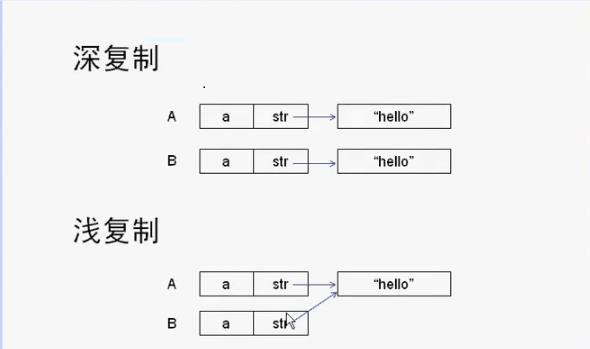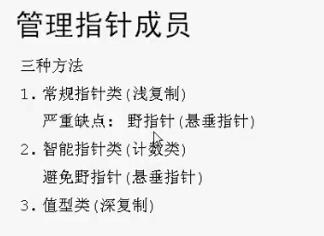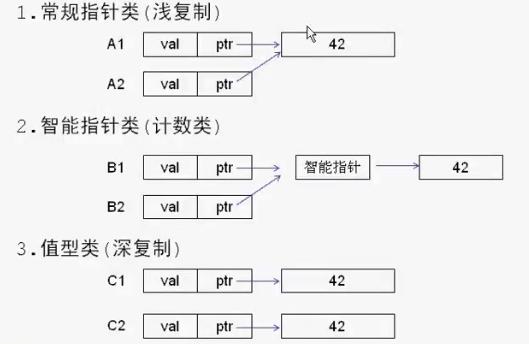C++学习基础七——深复制与浅复制
Posted bky2016
tags:
篇首语:本文由小常识网(cha138.com)小编为大家整理,主要介绍了C++学习基础七——深复制与浅复制相关的知识,希望对你有一定的参考价值。
一、深复制与浅复制基本知识
深复制和浅复制,又称为深拷贝和浅拷贝。
深复制和浅复制的区别如下图1所示:

图1
图1表示的是,定义一个类CDemo,包含int a和char *str两个成员变量,
当深复制时,A中的指针str与B中的指针str指向不同的地址,只是地址所指向的数据相同。
当浅复制时,A中的指针str与B中的指针str指向相同的地址。
1.浅复制:如果我们自己不实现复制构造函数,则C++会自动合成一个复制构造函数,又称为浅复制构造函数。
2.深复制:如果使用指针或者系统资源(如数据库,流对象等),则需要自己实现深复制的复制构造函数。
3.深复制与浅复制的代码区别:
1 Demo(const Demo &other) 2 { 3 this->id= other.id; 4 this->str = new char[1024];//深复制 ,该指针与 other内的指针变量指向两个不同的地址,只是数据相同 5 strcpy(this->str,other.str); 6 } 7 或者 8 Demo(const Demo &other) 9 { 10 this->id= other.id; 11 //深复制 ,该指针与 other内的指针变量指向两个不同的地址,只是数据相同 12 this->str = other.str; 13 } 14 Demo(const Demo &other) 15 { 16 this->id= other.id; 17 strcpy(this->str,other.str);//浅复制 18 }
4.如果自定义的类中包含指针,则应该自己实现深复制的复制构造函数,赋值操作符和析构函数。
二、管理指针成员
浅复制时因为两个指针指向相同的地址,很有可能出现野指针的情况;
深复制不会出现野指针,但会出现很多相同的对象,浪费内存。
如何有效的使用指针成员呢?管理指针成员的三个方法如图2所示:

图2
三种方式的具体区别如图3所示:

图3
总结:智能指针其实是浅复制,只是智能指针不会产生野指针,而浅复制会产生野指针。
1 #include <iostream> 2 3 using namespace std; 4 5 class ADemo 6 { 7 public: 8 ADemo(int v, const int &p) 9 { 10 val = v; 11 ptr = new int(p); 12 } 13 ~ADemo() 14 { 15 delete ptr; 16 } 17 18 ADemo(const ADemo &other) 19 { 20 val = other.val; 21 ptr = new int; 22 *ptr = *other.ptr;//深复制 23 } 24 25 ADemo& operator=(const ADemo &other) 26 { 27 val = other.val; 28 ptr = new int; 29 *ptr = *other.ptr;//深复制 30 return *this; 31 } 32 33 int get_ptr_val() 34 { 35 return *ptr; 36 } 37 void set_ptr(int v) 38 { 39 *ptr = v; 40 } 41 private: 42 int val; 43 int *ptr; 44 }; 45 46 class BDemo 47 { 48 public: 49 BDemo(int v, const int &p) 50 { 51 val = v; 52 ptr = new int(p); 53 } 54 ~BDemo() 55 { 56 delete ptr; 57 } 58 59 BDemo(const BDemo &other) 60 { 61 val = other.val; 62 ptr = other.ptr;//浅复制 63 } 64 65 BDemo& operator=(const BDemo &rig) 66 { 67 val = rig.val; 68 ptr = rig.ptr;//浅复制 69 return *this; 70 } 71 72 int get_ptr_val() 73 { 74 return *ptr; 75 } 76 void set_ptr(int v) 77 { 78 *ptr = v; 79 } 80 private: 81 int val; 82 int *ptr; 83 84 }; 85 86 //====================智能指针start============ 87 class U_Ptr 88 { 89 friend class CDemo; 90 private: 91 int *ptr; 92 size_t use; 93 U_Ptr(int *p,int u) 94 { 95 this->ptr = p; 96 use = u; 97 } 98 ~U_Ptr() 99 { 100 delete ptr; 101 } 102 } ; 103 104 class CDemo 105 {//智能指针 106 public: 107 CDemo(const int &p,int v) 108 { 109 ptr = new U_Ptr(new int(p),1); 110 val = v; 111 } 112 ~CDemo() 113 { 114 if(--ptr->use == 0)delete ptr; 115 } 116 117 CDemo(const CDemo &other) 118 { 119 ++ptr->use;//多了一个对象使用 120 val = other.val; 121 ptr = other.ptr;//浅复制 122 } 123 CDemo& operator=(const CDemo &rig) 124 { 125 ++rig.ptr->use; 126 if(--ptr->use == 0)delete ptr; 127 128 val = rig.val; 129 ptr = rig.ptr;//浅复制 130 return *this; 131 } 132 133 void set_Ptr_val(int v) 134 { 135 *ptr->ptr = v; 136 } 137 138 int get_ptr_val() 139 { 140 return *ptr->ptr; 141 } 142 private: 143 int val; 144 U_Ptr *ptr; 145 }; 146 147 void test_ShenCopy() 148 { 149 int prr = 20; 150 ADemo a(10,prr); 151 ADemo b = a; 152 cout<<"a = "<<a.get_ptr_val()<<endl; 153 cout<<"b = "<<b.get_ptr_val()<<endl; 154 cout<<"修改之后:"<<endl; 155 a.set_ptr(40); 156 cout<<"a = "<<a.get_ptr_val()<<endl; 157 cout<<"b = "<<b.get_ptr_val()<<endl; 158 } 159 void test_QianCopy() 160 { 161 162 int prr = 40; 163 BDemo a(50,prr); 164 BDemo b = a; 165 cout<<"a = "<<a.get_ptr_val()<<endl; 166 cout<<"b = "<<b.get_ptr_val()<<endl; 167 cout<<"修改之后:"<<endl; 168 b.set_ptr(80); 169 cout<<"a = "<<a.get_ptr_val()<<endl; 170 cout<<"b = "<<b.get_ptr_val()<<endl; 171 } 172 173 void test_smart() 174 { 175 int prr = 90; 176 CDemo a(100,prr); 177 CDemo b = a; 178 cout<<"a = "<<a.get_ptr_val()<<endl; 179 cout<<"b = "<<b.get_ptr_val()<<endl; 180 cout<<"修改之后:"<<endl; 181 b.set_Ptr_val(180); 182 cout<<"a = "<<a.get_ptr_val()<<endl; 183 cout<<"b = "<<b.get_ptr_val()<<endl; 184 } 185 int main() 186 { 187 cout<<"深复制:"<<endl; 188 test_ShenCopy(); 189 cout<<endl<<"浅复制:"<<endl; 190 test_QianCopy(); 191 cout<<endl<<"智能指针:"<<endl; 192 test_smart(); 193 return 0; 194 }
以上是关于C++学习基础七——深复制与浅复制的主要内容,如果未能解决你的问题,请参考以下文章